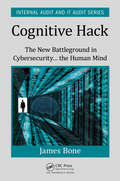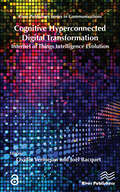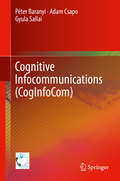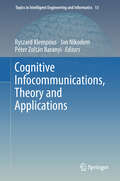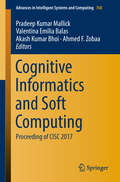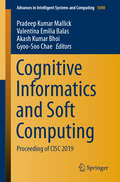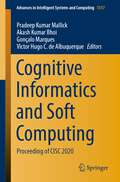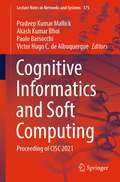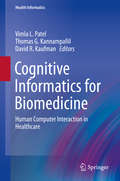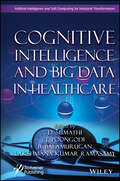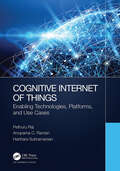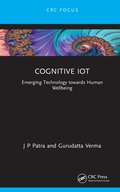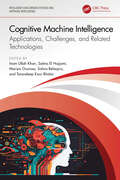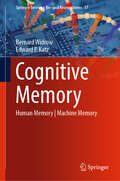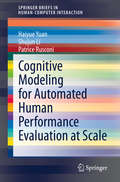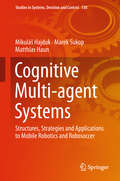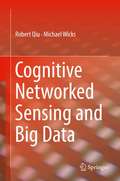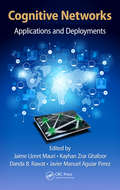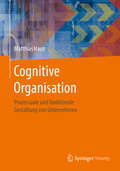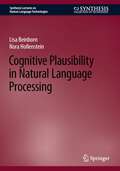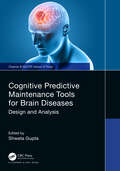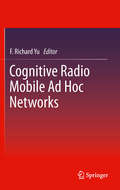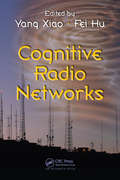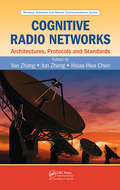- Table View
- List View
Cognitive Hack: The New Battleground in Cybersecurity ... the Human Mind (Security, Audit and Leadership Series)
by James BoneThis book explores a broad cross section of research and actual case studies to draw out new insights that may be used to build a benchmark for IT security professionals. This research takes a deeper dive beneath the surface of the analysis to uncover novel ways to mitigate data security vulnerabilities, connect the dots and identify patterns in the data on breaches. This analysis will assist security professionals not only in benchmarking their risk management programs but also in identifying forward looking security measures to narrow the path of future vulnerabilities.
Cognitive Hyperconnected Digital Transformation: Internet of Things Intelligence Evolution
by Ovidiu Vermesan Joël BacquetCognitive Hyperconnected Digital Transformation provides an overview of the current Internet of Things (IoT) landscape, ranging from research, innovation and development priorities to enabling technologies in a global context. It is intended as a standalone book in a series that covers the Internet of Things activities of the IERC-Internet of Things European Research Cluster, including both research and technological innovation, validation and deployment. The book builds on the ideas put forward by the European Research Cluster, the IoT European Platform Initiative (IoT-EPI) and the IoT European Large-Scale Pilots Programme, presenting global views and state-of-the-art results regarding the challenges facing IoT research, innovation, development and deployment in the next years. Hyperconnected environments integrating industrial/business/consumer IoT technologies and applications require new IoT open systems architectures integrated with network architecture (a knowledge-centric network for IoT), IoT system design and open, horizontal and interoperable platforms managing things that are digital, automated and connected and that function in real-time with remote access and control based on Internet-enabled tools. The IoT is bridging the physical world with the virtual world by combining augmented reality (AR), virtual reality (VR), machine learning and artificial intelligence (AI) to support the physical-digital integrations in the Internet of mobile things based on sensors/actuators, communication, analytics technologies, cyber-physical systems, software, cognitive systems and IoT platforms with multiple functionalities. These IoT systems have the potential to understand, learn, predict, adapt and operate autonomously. They can change future behaviour, while the combination of extensive parallel processing power, advanced algorithms and data sets feed the cognitive algorithms that allow the IoT systems to develop new services and propose new solutions. IoT technologies are moving into the industrial space and enhancing traditional industrial platforms with solutions that break free of device-, operating system- and protocol-dependency. Secure edge computing solutions replace local networks, web services replace software, and devices with networked programmable logic controllers (NPLCs) based on Internet protocols replace devices that use proprietary protocols. Information captured by edge devices on the factory floor is secure and accessible from any location in real time, opening the communication gateway both vertically (connecting machines across the factory and enabling the instant availability of data to stakeholders within operational silos) and horizontally (with one framework for the entire supply chain, across departments, business units, global factory locations and other markets). End-to-end security and privacy solutions in IoT space require agile, context-aware and scalable components with mechanisms that are both fluid and adaptive. The convergence of IT (information technology) and OT (operational technology) makes security and privacy by default a new important element where security is addressed at the architecture level, across applications and domains, using multi-layered distributed security measures. Blockchain is transforming industry operating models by adding trust to untrusted environments, providing distributed security mechanisms and transparent access to the information in the chain. Digital technology platforms are evolving, with IoT platforms integrating complex information systems, customer experience, analytics and intelligence to enable new capabilities and business models for digital business.
Cognitive Infocommunications (CogInfoCom)
by Péter Baranyi Adam Csapo Gyula SallaiThis book describes the theoretical foundations of cognitive infocommunications (CogInfoCom), and provides a survey on state-of-the-art solutions and applications within the field. The book covers aspects of cognitive infocommunications in research fields such as affective computing, BCI, future internet, HCI, HRI, sensory substitution, and virtual/augmented interactions, and also introduces newly proposed paradigms and initiatives under the field, including CogInfoCom channels, speechability and socio-cognitive ICT. The book focuses on describing the merging between humans and information and communications technology (ICT) at the level of cognitive capabilities with an approach towards developing future cognitive ICT.
Cognitive Infocommunications, Theory and Applications (Topics in Intelligent Engineering and Informatics #13)
by Ryszard Klempous Jan Nikodem Péter Zoltán BaranyiThe book gathers the chapters of Cognitive InfoCommunication research relevant to a variety of application areas, including data visualization, emotion expression, brain-computer interfaces or speech technologies. It provides an overview of the kind of cognitive capabilities that are being analyzed and developed. Based on this common ground, it may become possible to see new opportunities for synergy among disciplines that were heretofore viewed as being separate.Cognitive InfoCommunication begins by modeling human cognitive states and aptitudes in order to better understand what the user of a system is capable of comprehending and doing. The patterns of exploration and the specific tools that are described can certainly be of interest and of great relevance for all researchers who focus on modeling human states and aptitudes.This innovative research area provides answers to the latest challenges in influence of cognitive states and aptitudes in order to facilitate learning or generally improve performance in certain cognitive tasks such as decision making. Some capabilities are purely human, while others are purely artificial, but in general this distinction is rarely clear-cut. Therefore, when discussing new human cognitive capabilities, the technological background which makes them possible cannot be neglected, and indeed often plays a central role.This book highlights the synergy between various fields that are perfectly fit under the umbrella of CogInfoCom and contribute to understanding and developing new, human-artificial intelligence hybrid capabilities. These, merged capabilities are currently appearing, and the importance of the role they play in everyday life are unique to the cognitive entity generation that is currently growing up.
Cognitive Informatics and Soft Computing: Proceeding of CISC 2017 (Advances in Intelligent Systems and Computing #768)
by Valentina Emilia Balas Ahmed F. Zobaa Akash Kumar Bhoi Pradeep Kumar MallickThe book presents new approaches and methods for solving real-world problems. It offers, in particular, exploratory research that describes novel approaches in the fields of Cognitive Informatics, Cognitive Computing, Computational Intelligence, Advanced Computing, Hybrid Intelligent Models and Applications. New algorithms and methods in a variety of fields are also presented, together with solution-based approaches. The topics addressed include various theoretical aspects and applications of Computer Science, Artificial Intelligence, Cybernetics, Automation Control Theory and Software Engineering.
Cognitive Informatics and Soft Computing: Proceeding of CISC 2019 (Advances in Intelligent Systems and Computing #1040)
by Valentina Emilia Balas Akash Kumar Bhoi Pradeep Kumar Mallick Gyoo-Soo ChaeThe book presents new approaches and methods for solving real-world problems. It highlights, in particular, innovative research in the fields of Cognitive Informatics, Cognitive Computing, Computational Intelligence, Advanced Computing, and Hybrid Intelligent Models and Applications. New algorithms and methods in a variety of fields are presented, together with solution-based approaches. The topics addressed include various theoretical aspects and applications of Computer Science, Artificial Intelligence, Cybernetics, Automation Control Theory, and Software Engineering.
Cognitive Informatics and Soft Computing: Proceeding of CISC 2020 (Advances in Intelligent Systems and Computing #1317)
by Akash Kumar Bhoi Pradeep Kumar Mallick Victor Hugo C. de Albuquerque Gonçalo MarquesThis book presents best selected research papers presented at the 3rd International Conference on Cognitive Informatics and Soft Computing (CISC 2020), held at Balasore College of Engineering & Technology, Balasore, Odisha, India, from 12 to 13 December 2020. It highlights, in particular, innovative research in the fields of cognitive informatics, cognitive computing, computational intelligence, advanced computing, and hybrid intelligent models and applications. New algorithms and methods in a variety of fields are presented, together with solution-based approaches. The topics addressed include various theoretical aspects and applications of computer science, artificial intelligence, cybernetics, automation control theory, and software engineering.
Cognitive Informatics and Soft Computing: Proceeding of CISC 2021 (Lecture Notes in Networks and Systems #375)
by Akash Kumar Bhoi Pradeep Kumar Mallick Victor Hugo C. de Albuquerque Paolo BarsocchiThis book presents best selected research papers presented at the 4th International Conference on Cognitive Informatics and Soft Computing (CISC 2021), held at Balasore College of Engineering & Technology, Balasore, Odisha, India, from 21–22 August 2021. It highlights, in particular, innovative research in the fields of cognitive informatics, cognitive computing, computational intelligence, advanced computing, and hybrid intelligent models and applications. New algorithms and methods in a variety of fields are presented, together with solution-based approaches. The topics addressed include various theoretical aspects and applications of computer science, artificial intelligence, cybernetics, automation control theory, and software engineering.
Cognitive Informatics for Biomedicine: Human Computer Interaction in Healthcare (Health Informatics)
by Vimla L. Patel Thomas G. Kannampallil David R. KaufmanThe book reports on the current state on HCI in biomedicine and health care, focusing on the role of human factors, patient safety well as methodological underpinnings of HCI theories and its application for biomedical informatics. Theories, models and frameworks for human-computer interaction (HCI) have been recognized as key contributors for the design, development and use of computer-based systems. In the clinical domain, key themes that litter the research landscape of health information technology (HIT) are usability, decision support and clinical workflow - all of which are affected directly or indirectly by the nature of HCI. While the implications of HCI principles for the design of HIT are acknowledged, the adoption of the tools and techniques among clinicians, informatics researchers and developers of HIT are limited. There is a general consensus that HIT has not realized its potential as a tool to facilitate clinical decision-making, the coordination of care and improves patient safety. Embracing sound principles of iterative design can yield significant dividends. It can also enhance practitioner's abilities to meet "meaningful use" requirements. The purpose of the book is two-fold: to address key gaps on the applicability of theories, models and evaluation frameworks of HCI and human factors for research in biomedical informatics. It highlights the state of the art, drawing from the current research in HCI. Second, it also serves as a graduate level textbook highlighting key topics in HCI relevant for biomedical informatics, computer science and social science students working in the healthcare domain. For instructional purposes, the book provides additional information and a set of questions for interactive class discussion for each section. The purpose of these questions is to encourage students to apply the learned concepts to real world healthcare problems.
Cognitive Intelligence and Big Data in Healthcare (Artificial Intelligence and Soft Computing for Industrial Transformation)
by B. Balamurugan T. Poongodi D. Sumathi Lakshmana Kumar RamasamyCOGNITIVE INTELLIGENCE AND BIG DATA IN HEALTHCARE Applications of cognitive intelligence, advanced communication, and computational methods can drive healthcare research and enhance existing traditional methods in disease detection and management and prevention. As health is the foremost factor affecting the quality of human life, it is necessary to understand how the human body is functioning by processing health data obtained from various sources more quickly. Since an enormous amount of data is generated during data processing, a cognitive computing system could be applied to respond to queries, thereby assisting in customizing intelligent recommendations. This decision-making process could be improved by the deployment of cognitive computing techniques in healthcare, allowing for cutting-edge techniques to be integrated into healthcare to provide intelligent services in various healthcare applications. This book tackles all these issues and provides insight into these diversified topics in the healthcare sector and shows the range of recent innovative research, in addition to shedding light on future directions in this area. Audience The book will be very useful to a wide range of specialists including researchers, engineers, and postgraduate students in artificial intelligence, bioinformatics, information technology, as well as those in biomedicine.
Cognitive Internet of Things: Enabling Technologies, Platforms, and Use Cases
by Pethuru Raj Harihara Subramanian Anupama C. RamanThe Internet of Things (IoT) concept is defined as a flexible and futuristic network where all the different types of devices and smart objects can become seamlessly connected to each other and can actively participate in all types of processes which are happening around us. The grand objective of making physical, mechanical, electrical, and electronic devices to use the deeper and extreme connectivity and service-enablement techniques is to make them intelligent in their deeds, decisions, and deals. Cognitive IoT is the application of cognitive computing technologies to the data which is generated by the connected devices of the IoT ecosystem. Cognition means thinking; however, computers are not yet fully capable of mimicking human like thought. However, the present-day computer systems can perform some functions which are like the capability of human beings to think. Cognitive Internet of Things: Enabling Technologies, Platforms, and Use Cases explains the concepts surrounding Cognitive IoT. It also looks at the use cases and such supporting technologies as artificial intelligence and machine learning that act as key enablers of Cognitive IoT ecosystem. Different Cognitive IoT enabled platforms like IBM Watson and other product specific use cases like Amazon Alexa are covered in depth. Other highlights of the book include: Demystifying the cognitive computing paradigm Delineating the key capabilities of cognitive cloud environments Deep learning algorithms for cognitive IoT solutions Natural language processing (NLP) methods for cognitive IoT systems Designing a secure infrastructure for cognitive IoT platforms and applications
Cognitive IoT: Emerging Technology towards Human Wellbeing (Intelligent Signal Processing and Data Analysis)
by J P Patra Gurudatta VermaThis book deals with a different research area of cognitive IoT and explains how machine learning algorithms can be applied for cognitive IoT. It deals with applications of cognitive IoT in this pandemic (COVID-19), applications for student performance evaluation, applications for human healthcare for chronic disease prediction, use of wearable sensors and review regarding their energy optimization and how cognitive IoT helps in farming through rainfall prediction and prediction of lake levels. Features: Describes how cognitive IoT is helpful for chronic disease prediction and processing of data gathered from healthcare devices. Explains different sensors available for health monitoring. Explores application of cognitive IoT in COVID-19 analysis. Discusses pertinent and efficient farming applications for sustaining agricultural growth. Reviews smart educational aspects such as student response, performance, and behavior and instructor response, performance, and behavior. This book aims at researchers, professionals and graduate students in Computer Science and Engineering, Computer Applications and Electronics Engineering, and Wireless Communications and Networking.
Cognitive Machine Intelligence: Applications, Challenges, and Related Technologies (Intelligent Data-Driven Systems and Artificial Intelligence)
by Mariya Ouaissa Inam Ullah Khan Salma El Hajjami Tarandeep Kaur Bhatia Salwa BelaqzizCognitive Machine Intelligence: Applications, Challenges, and Related Technologies offers a compelling exploration of the transformative landscape shaped by the convergence of machine intelligence, artificial intelligence, and cognitive computing. In this book, the authors navigate through the intricate realms of technology, unveiling the profound impact of cognitive machine intelligence on diverse fields such as communication, healthcare, cybersecurity, and smart city development. The chapters present study on robots and drones to the integration of machine learning with wireless communication networks, IoT, quantum computing, and beyond. The book explores the essential role of machine learning in healthcare, security, and manufacturing. With a keen focus on privacy, trust, and the improvement of human lifestyles, this book stands as a comprehensive guide to the novel techniques and applications driving the evolution of cognitive machine intelligence. The vision presented here extends to smart cities, where AI-enabled techniques contribute to optimal decision-making, and future computing systems address end-to-end delay issues with a central focus on Quality-of-Service metrics. Cognitive Machine Intelligence is an indispensable resource for researchers, practitioners, and enthusiasts seeking a deep understanding of the dynamic landscape at the intersection of artificial intelligence and cognitive computing.This book: Covers a comprehensive exploration of cognitive machine intelligence and its intersection with emerging technologies such as federated learning, blockchain, and 6G and beyond. Discusses the integration of machine learning with various technologies such as wireless communication networks, ad-hoc networks, software-defined networks, quantum computing, and big data. Examines the impact of machine learning on various fields such as healthcare, unmanned aerial vehicles, cybersecurity, and neural networks. Provides a detailed discussion on the challenges and solutions to future computer networks like end-to-end delay issues, Quality of Service (QoS) metrics, and security. Emphasizes the need to ensure privacy and trust while implementing the novel techniques of machine intelligence. It is primarily written for senior undergraduate and graduate students, and academic researchers in the fields of electrical engineering, electronics and communication engineering, and computer engineering.
Cognitive Memory: Human Memory | Machine Memory (Springer Series on Bio- and Neurosystems #17)
by Bernard Widrow Edward P. KatzHow does human memory work? How does human pattern recognition work? The book’s motivation is twofold, to add to knowledge in the field of neuroscience, and to design a highly simplified cognitive memory constructed using software and existing electronic components. Readers are taken on an inspiring journey through the fundamentals of human memory, how it is constructed, and how it works in everyday life. The book goes more in-depth into the human side of cognitive memory — how seeing, hearing, walking and speaking works. Impairments in cognitive memory are also discussed. Lastly, the book sheds light on how meaning is extracted from sensory inputs and from stored data. This book is not without controversy. Neuroscientists accept the engrams (or memory traces) model that long-term memory is stored in the brain’s neural networks. The authors believe that long-term human memory is stored digitally, in the DNA of brain cells, and not in analog neural networks. Further, the authors believe that innate knowledge of humans and animals is inherited, transmitted from parents to offspring at the moment of conception. The single cell contains the innate knowledge in the DNA of its nucleus. Memory is stored in DNA. The brain’s neural networks are for access and retrieval of memory and not for actual storage. This book offers a unique, inspiring reading to researchers and other readers interested in the science of memory.
Cognitive Modeling for Automated Human Performance Evaluation at Scale (Human–Computer Interaction Series)
by Shujun Li Haiyue Yuan Patrice RusconiCognitive models and software tools have been widely used for both research and commercial purposes. Although they have proved very useful, there are some limitations preventing large-scale modeling and simulation tasks to be carried out efficiently and effectively. In this book, we aim to provide readers with a systematic overview of state-of-the-art cognitive modeling software tools and applications and an introduction to a new software framework for facilitating large-scale modeling and simulation of human-performance tasks. The authors first review cognitive modeling theories and then present an overview of state-of-the-art software tools for cognitive modeling and simulation. Finally, the book focuses on the new software framework and a research prototype called CogTool+, including how to incorporate behavioral data such as eye-tracking data in modeling and simulation tasks. Typical applications of CogTool+ in HCI and cyber security are given to demonstrate its usefulness.
Cognitive Multi-agent Systems: Structures, Strategies and Applications to Mobile Robotics and Robosoccer (Studies in Systems, Decision and Control #138)
by Matthias Haun Mikuláš Hajduk Marek SukopThe book describes an approach to the multi-agent systems (MAS) design for applications of robotic soccer in the MiroSot category. The described MAS is designed for dynamic, quickly changing environments, in which not only the actions of our MAS are observed, but also those of the opposing MAS. It actively tries to affect the environment to score goals faster than the opposing MAS. Multi-agent systems (MAS) are mostly applied in the environments in which they exist and act without an opposing system. The book also describes strategies based on a supervisor that makes decisions depending on behavior prediction of the opposing MAS and the ball movement in the working place. A sophisticated distribution of tasks was designed for each agent to cooperate in order score goals as fast as possible. Simultaneously, these agents try, by permitted means, to prevent the enemy agents from scoring goals. The approach described is an excellent guide to the constantly evolving abilities of mobile robotics, both for real-world applications, such as cooperation of multiple robots in life-saving activities, and for the steadily developing applications of mobile robots in various robotic competitions (e.g. Robocup, etc.). The book provides readers with high-level knowledge on how to design strategies and how to implement such systems, and the ideas presented enable them to further refine the approach utilizing the latest hardware and use it in new systems implementations of sophisticated intelligent engineering.
Cognitive Networked Sensing and Big Data
by Michael Wicks Robert QiuWireless Distributed Computing and Cognitive Sensing defines high-dimensional data processing in the context of wireless distributed computing and cognitive sensing. This book presents the challenges that are unique to this area such as synchronization caused by the high mobility of the nodes. The author will discuss the integration of software defined radio implementation and testbed development. The book will also bridge new research results and contextual reviews. Also the author provides an examination of large cognitive radio network; hardware testbed; distributed sensing; and distributed computing.
Cognitive Networks: Applications and Deployments
by Danda B. Rawat Jaime Lloret Mauri Kayhan Zrar Ghafoor Javier Manuel Aguiar PerezA cognitive network makes use of the information gathered from the network in order to sense the environment, plan actions according to the input, and make appropriate decisions using a reasoning engine. The ability of cognitive networks to learn from the past and use that knowledge to improve future decisions makes them a key area of interest for
Cognitive Neuroscience of Natural Language Use
by Roel M. WillemsWhen we think of everyday language use, the first things that come to mind include colloquial conversations, reading and writing e-mails, sending text messages or reading a book. But can we study the brain basis of language as we use it in our daily lives? As a topic of study, the cognitive neuroscience of language is far removed from these language-in-use examples. However, recent developments in research and technology have made studying the neural underpinnings of naturally occurring language much more feasible. In this book a range of international experts provide a state-of-the-art overview of current approaches to making the cognitive neuroscience of language more 'natural' and closer to language use as it occurs in real life. The chapters explore topics including discourse comprehension, the study of dialogue, literature comprehension and the insights gained from looking at natural speech in neuropsychology.
Cognitive Organisation: Prozessuale und funktionale Gestaltung von Unternehmen
by Matthias HaunDie in dem Buch beschriebenen Methoden und Techniken sichern Unternehmen den Entwicklungsvorsprung, der ben#65533;tigt wird, um mit hoher Innovations- und Zukunftssicherheit in organisatorischer und technologischer Hinsicht auf dynamischen M#65533;rkten zu bestehen. Der innovative Ansatz stellt die Begriffe Kognition, Organisation, Wissen und Technologie in den Mittelpunkt. Mit Hilfe der wissensbasierten, handlungsorientierten und simulationsvalidierten Methodik k#65533;nnen innovative Unternehmen als kognitive, wandelbare Organisationen entwickelt werden.
Cognitive Plausibility in Natural Language Processing (Synthesis Lectures on Human Language Technologies)
by Lisa Beinborn Nora HollensteinThis book explores the cognitive plausibility of computational language models and why it’s an important factor in their development and evaluation. The authors present the idea that more can be learned about cognitive plausibility of computational language models by linking signals of cognitive processing load in humans to interpretability methods that allow for exploration of the hidden mechanisms of neural models. The book identifies limitations when applying the existing methodology for representational analyses to contextualized settings and critiques the current emphasis on form over more grounded approaches to modeling language. The authors discuss how novel techniques for transfer and curriculum learning could lead to cognitively more plausible generalization capabilities in models. The book also highlights the importance of instance-level evaluation and includes thorough discussion of the ethical considerations that may arise throughout the various stages of cognitive plausibility research.
Cognitive Predictive Maintenance Tools for Brain Diseases: Design and Analysis (Chapman & Hall/CRC Internet of Things)
by Shweta GuptaThis book involves the design, analysis, and application of various cognitive predictive maintenance tests with the help of tools like vibration analysis, ultrasonic analysis, infrared analysis, oil analysis, laser-shaft alignment, and motor circuit analysis in the prediction of various cognitive diseases such as epilepsy, Parkinson’s disease, Alzheimer’s disease, and depression. These are needed since there are no proper medical tests available to predict these diseases in remote areas at an early stage. Various emerging technologies are analyzed for the design of tests. Key features: Incorporates innovative processes for treating cognitive diseases. Early and exact identification and treatment strategies are incorporated. Future technologies like artificial intelligence, machine learning, the IoT, and data science are used to find solutions. Analysis with existing cognitive disease solutions is incorporated and simulations provided. The novelty of the book lies in the accurate prediction of cognitive diseases. Encompassing future technologies and various communication protocols or devices available for cognitive diseases for the design of new equipment are an outcome of the book. Various parameters like power consumption, productivity, and safety should be taken into account during the analysis, design, and application of a product. The book could well be added to the curriculum of medical colleges and biomedical engineering students. Possible vendors include biomedical research centers like Biotechnika and the Indian Council of Medical Research (ICMR). It would be a breakthrough for biomedical companies to launch their new products.
Cognitive Radio Mobile Ad Hoc Networks
by F. Richard YuCognitive radios (CR) technology is capable of sensing its surrounding environment and adapting its internal states by making corresponding changes in certain operating parameters. CR is envisaged to solve the problems of the limited available spectrum and the inefficiency in the spectrum usage. CR has been considered in mobile ad hoc networks (MANETs), which enable wireless devices to dynamically establish networks without necessarily using a fixed infrastructure. The changing spectrum environment and the importance of protecting the transmission of the licensed users of the spectrum mainly differentiate classical MANETs from CR-MANETs. The cognitive capability and re-configurability of CR-MANETs have opened up several areas of research which have been explored extensively and continue to attract research and development. The book will describe CR-MANETs concepts, intrinsic properties and research challenges of CR-MANETs. Distributed spectrum management functionalities, such as spectrum sensing and sharing, will be presented. The design, optimization and performance evaluation of security issues and upper layers in CR-MANETs, such as transport and application layers, will be investigated.
Cognitive Radio Networks
by Ian MuehlenhausFueled by ongoing and increasing consumer demand, the explosive growth in spectrum-based communications continues to tax the finite resources of the available spectrum. One possible solution, Cognitive Radio Network (CRN), allows unlicensed users opportunistic access to licensed bands without interfering with existing users. Although some initial s
Cognitive Radio Networks: Architectures, Protocols, and Standards
by Yan Zhang Jun Zheng Hsiao-Hwa ChenWhile still in the early stages of research and development, cognitive radio is a highly promising communications paradigm with the ability to effectively address the spectrum insufficiency problem. Written by those pioneering the field, Cognitive Radio Networks: Architectures, Protocols, and Standards offers a complete view of cognitive radio-incl
